Introduction
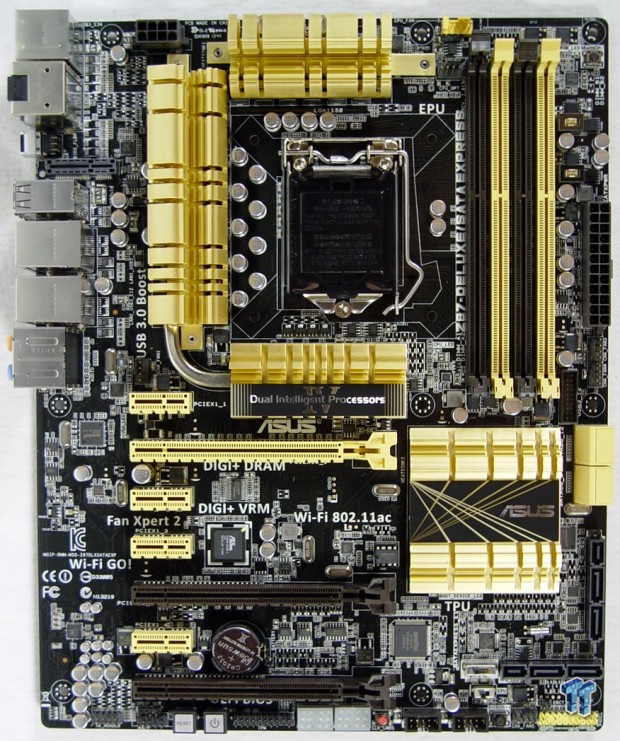
In May 2011, SandForce released the first SSD bottlenecked by the SATA III bus. It was just five months after Intel released the P67 Express chipset, Intel's first native SATA III capable release. Until then, PATA and SATA lived long, fulfilling lives, always ahead of the performance curve offered by new data storage products. This fact is just one reason why we call flash-based storage a disruptive technology.

Photo for demonstration purposes only
The standards body, SATA-I/O, quickly jumped into action. The logical choice was to double performance again, going from 6Gbps to 12Gbps. What the group found was that the interface would need signification changes, shielding, and additional development time. This led to additional development time, but in 2013, SATA-I/O published the SATA 3.2 specifications, this time with a viable solution for quick implementation and a way to reduce cost. SATA-I/O went PCI Express.
The move to PCI Express provides an instant performance increase from 6Gbps to 8Gbps via two PCI Express 2.0 lanes. SATA Express standardizes a 2.5" form factor to move the drives away from your motherboard and in the way of multi-GPU configurations.
Moving forward from what we're showing today, SATA Express has several upgrade paths. The first is a shift to PCIE 3.0 where advanced 128b/130b encoding increases efficiency from 80% to 98.5%. Both SATA and PCIe 2.0 use 8b/10b encoding, so 20% of the available bandwidth if used for overhead. PCIe 3.0 reduces the overhead to just 1.5%.
The other option we'll see from controller makers is increasing the number of lanes to the SSD controller, but that won't be possible over SATA Express since it's limited to just two lanes. Over PCIe 2.0 that means 1000 MB/s or 800 MB/s after overhead.
ASUS sent us an early motherboard prototype sample that supports SATA Express. So, let's check it out and see some early performance numbers.
ASUS Z87 based SATA Express Prototype

Even though the rest of the market isn't ready to deliver SATA Express, ASUS certainly is. The company was kind enough to send us a new prototype motherboard used for testing SATA Express. The boards' label reads Z87 Deluxe / SATA Express, and it follows the same look found on many of the company's current award winning products.
What makes this product different is the inclusion of two SATA Express ports on the lower right hand corner. The first connector links to the Intel PCH directly and the second to a third-party bridge.

For years, we've heard rumblings about dedicated PCIe based storage on Intel platforms. The current chipsets offer flexible placement with enough PCIe to dedicate lanes to storage.

Here we get our first look at the new connector. Each provides two SATA III ports for two devices or one SATA Express port for a single device.
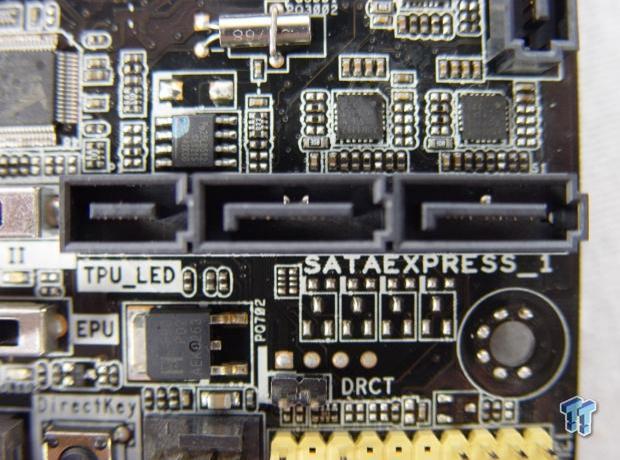
Essentially, what SATA-I/O managed to develop is a PCIe lane ran through a SATA connector. Two SATA connectors carry two PCIe lanes, but that's still not enough pins to transmit the full signal. SATA uses 7 pins, but the full SATA Express pin count is 18, thus we have an extra block off to the side.
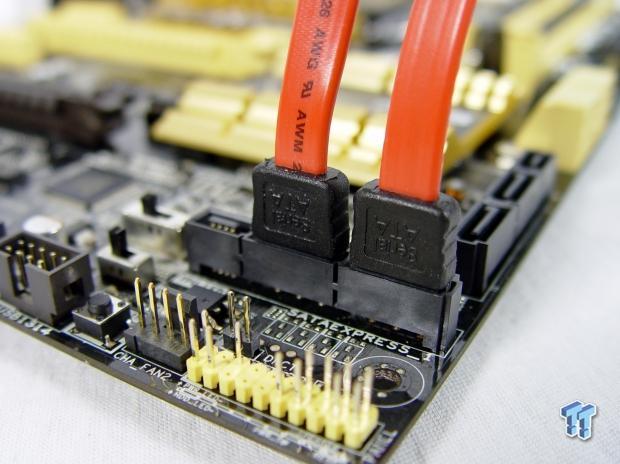
Traditional SATA cables in SATA Express.
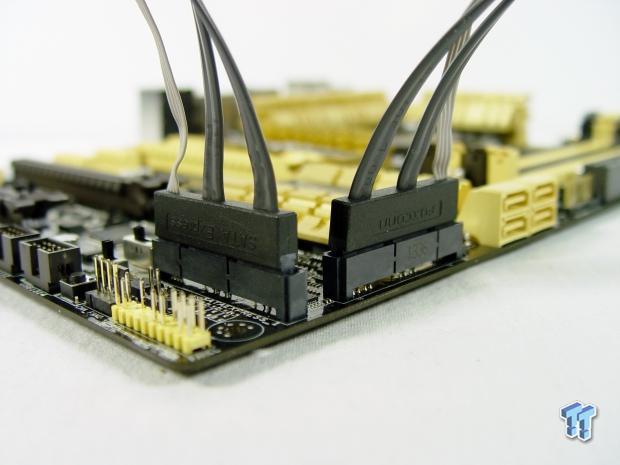
SATA Express cables in the new interface.

At this time, ASUS is putting the finishing touches on the design and cable markers are as well. Eventually we plan to see more refined cables with bundled in a single sleeve.

As we mentioned, there aren't any SATA Express SSDs available at this time, at least not in this specific form factor. Since SATA Express is PCIe Express, it's possible to convert the SATA Express signal into a PCI Express slot for PCIe form factor products like the recently reviewed ASUS ROG RAIDR Express.
ASUS provided us with a special adapter to do just that. The prototype name is "Runway".

Two additional pins carry the PCIe clock signal to the adapter.
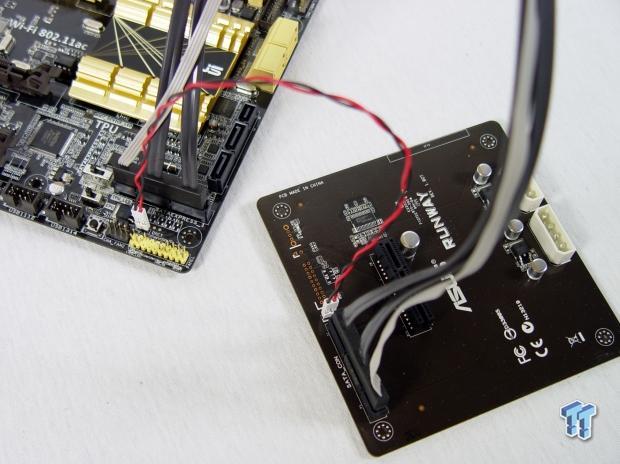
More on SATA Express

Before we dive into testing, let's take a look at some of the finer details surrounding SATA Express and other PCIe based storage platforms. Then we'll test the system provided by ASUS with the ROG RAIDR and a native PCIe SSD - a SanDisk A110.

As mentioned, Intel provides ample PCIe lanes for motherboard makers to incorporate SATA Express today.

Until recently, PCIe based storage meant expensive add-in cards. Native PCIe meant high-dollar products from companies like Fusion-io or controllers from IDT (now owned by PMC Sierra), found in the Micron P320h. Both products intended for enterprise use.
Moving forward, enterprise products move to the new SFF-8639 interface for up to four PCIe lanes in a 2.5" form factor. Consumer products use SATA Express with two PCIe lanes.

Forward Insights predicts a slower adaption for PCIe based storage than we observed with SATA 6Gb/s. A slow economy, mixed with a large base of existing platforms slow progress, but I suspect the reduced cost of PCIe based storage will entice the enthusiast and power user markets.
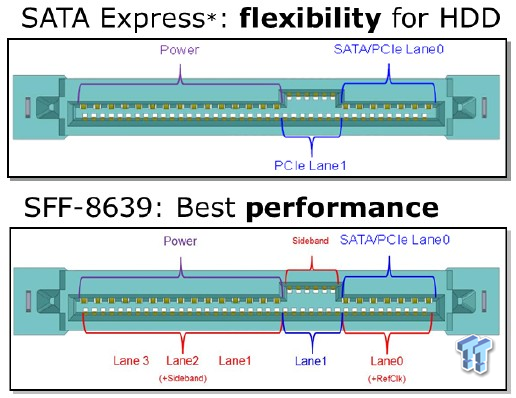
The electronics for both SATA Express and SF-8639 connectors are identical aside from the extra data paths for SFF-8639.

We did find a picture of a proposed SATA Express connector and it appears the comities are not ready to fully merge consumer and enterprise into one universal connector. The tab in the middle will block SFF-8639 from some SATA Express specific backplanes and cables if this proposed connector is in fact the final design.
Benchmarks - Test System Setup
Desktop Test System

As mentioned, we're using an ASUS prototype motherboard and engineering sample adapter to convert the SATA Express signal into a traditional PCIe 2.0 2 lane. It is very important to remember that the numbers you see here today at TweakTown may not be fully indicative of the final numbers you will see on production / shipping systems.
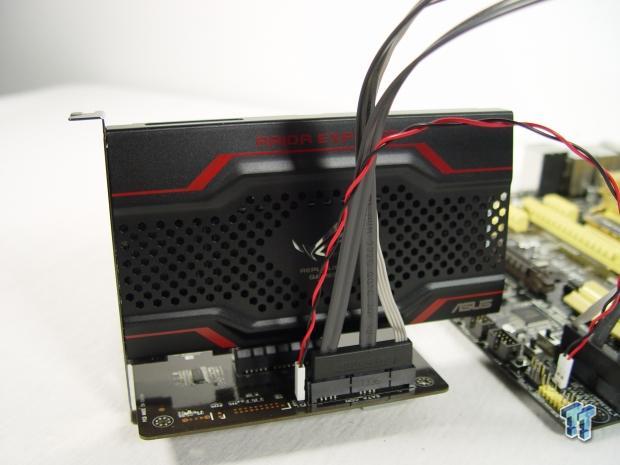
For our test today, we're using the ASUS ROG RAIDR Express, a well performing PCIe to RAID SATA SSD that has an impressive appearance.
We're also testing with an early sample SanDisk A110 SSD. The A110 has a native PCIe interface via an M.2 2260 connector. The controller is from Marvell and we're using an adapter provided by SanDisk to allow for PCIe connectivity.
ASUS ROG RAIDR Express Performance
ASUS ROG RAIDR Express

ATTO Disk Benchmark
Version and / or Patch Used: 2.34
Note: ATTO is a timeless benchmark used to provide manufactures with data used market storage products.

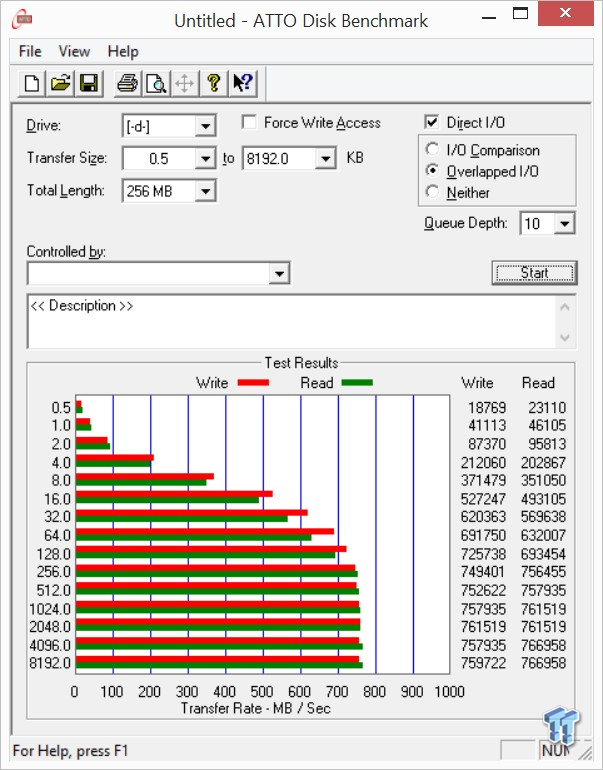
Our default test with ATTO uses a queue depth of 4 (left), but using a queue depth of 10 (right) shows increased performance by simulating higher multitasking.
The ASUS ROG RAIDR running over SATA Express delivers over 750 MB/s both read and write sequential transfers.
CrystalDiskMark
Version and / or Patch Used: 3.0 Technical Preview
Note: Crystal Disk Mark 3.0 Technical Preview was used for these tests since it offers the ability to measure native command queuing at 4 and 32.
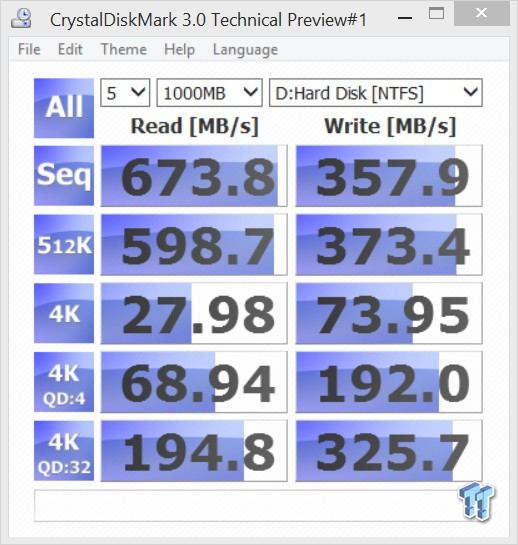
Our ROG RAIDR Express was pulled from an extended endurance test so the write speed is much lower than the fresh out of box state. Even in this state, the 4K write performance is quite high, over 70 MB/s.
For this test though, we're focusing on sequential read performance. This test uses incompressible data as well, so it's not the optimal method for showing peak performance with the LSI SandForce architecture.
AIDA64 Random Access Time
Version and / or Patch Used: 1.60
Note: AIDA64 offers several different benchmarks for testing and optimizing your system or network. The Random Access test is one of very few if not only that will measure hard drives random access times in hundredths of milliseconds as oppose to tens of milliseconds.

AIDA Read Latency (64KB)

AIDA Write Latency (64KB)
The read (top) and write (bottom) latency doesn't increase with the extra hop through the adapter. Since SATA Express is PCI Express, we didn't expect to gain any performance by using this format. What it will do though is decrease the cost of materials, and thus decrease the cost of retail products.
The ASUS ROG RAIDR Express also still convers the PCIe signal to SATA after the Marvell RAID controller. The two LSI SandForce controllers are electrically SATA still. Since SF-2281 controllers don't use a DRAM buffer to store table data, the latency is a bit higher than products using a buffer and of course native PCIe devices. We just so happen to have one of those somewhere... let me see if I can find it.
SanDisk A110 M.2 Native PCIe

The SanDisk A110 represents an early look at the type of performance we should expect from early SATA Express products. The Marvell 88SS9183 controller is available to SSD manufactures. At this time, we have four products on hand with the controller, but can't talk about three of them for a few more weeks.
The controller is native PCIe, but the form factor is M.2, formally known as NGFF.
ATTO Disk Benchmark
Version and / or Patch Used: 2.34
Note: ATTO is a timeless benchmark used to provide manufactures with data used market storage products.
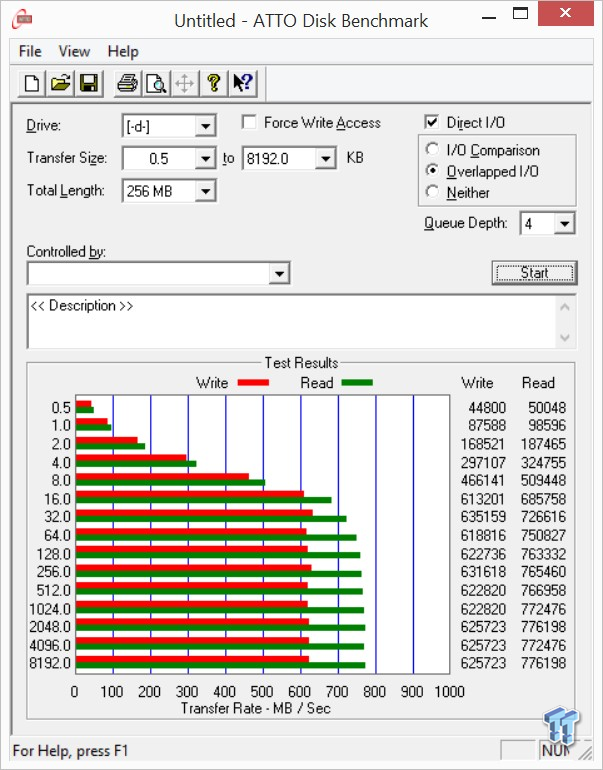

Again, we're looking at both the QD4 (left) and QD10 (right) sequential performance with ATTO.
The native PCIe Marvell controlled drive delivers higher sequential read performance, but lower sequential write performance compared to the ROG RAIDR Express.
We're not really trying to compare the two products today though, we're more concerned with the technology side of SATA Express and the fact that ASUS is ready to roll it into products that appear to be retail ready.
CrystalDiskMark
Version and / or Patch Used: 3.0 Technical Preview
Note: Crystal Disk Mark 3.0 Technical Preview was used for these tests since it offers the ability to measure native command queuing at 4 and 32.

CDM doesn't provide us any further insight since we're butting against the limits of the flash when it comes to 4K read and write performance. What we need is SLC with a native PCIe interface.
AIDA64 Random Access Time
Version and / or Patch Used: 1.60
Note: AIDA64 offers several different benchmarks for testing and optimizing your system or network. The Random Access test is one of very few if not only that will measure hard drives random access times in hundredths of milliseconds as oppose to tens of milliseconds.

AIDA Read Latency (64KB)

AIDA Write Latency (64KB)
I've tested a handful of products based on native PCIe and with different interfaces. Some products show a latency improvement when connected to the PCIe lanes directly off of the CPU, but most do not.
This goes to show how well Intel engineered the PCH and the lanes coming off it and the way ASUS implemented the design on the Maximus VI Extreme, the board I've used to develop my 2014 test regiment.
The native PCIe interface on the Marvell controlled drive with a DRAM buffer has great latency performance. Let's use this drive to test the ASMedia PCIe to SATA Express chip also on the ASUS prototype board.
ASMedia ASM106SE

Upon further investigation, we found that the second SATA Express port on the board came from an ASMedia ASM106SE bridge chip. We were not able to find any information about the new bridge online, but we have enough here to run it through the mill with some tests.
ASMedia was founded in 2004 by ASUSTeK Computer Group and specializes in digital and analog IC designs. We've seen ASMedia silicon used on a number of motherboards for USB, SATA and Thunderbolt. The ASM106SE appears to be the first SATA Express add-on bridge.
ATTO Disk Benchmark
Version and / or Patch Used: 2.34
Note: ATTO is a timeless benchmark used to provide manufactures with data used market storage products.


The sequential performance doesn't change when we move to the ASMedia ASM106SE SATA Express chip. This is a big change compared to years past when Intel dominated the performance of SATA hosts. Let's check the other areas.
CrystalDiskMark
Version and / or Patch Used: 3.0 Technical Preview
Note: Crystal Disk Mark 3.0 Technical Preview was used for these tests since it offers the ability to measure native command queuing at 4 and 32.

The 4K and 4K at depth performance is also nearly identical - definitely within the margin of error for this test.
AIDA64 Random Access Time
Version and / or Patch Used: 1.60
Note: AIDA64 offers several different benchmarks for testing and optimizing your system or network. The Random Access test is one of very few if not only that will measure hard drives random access times in hundredths of milliseconds as oppose to tens of milliseconds.

AIDA Read Latency (64KB)

AIDA Write Latency (64KB)
The read (top) and write (bottom) latency measurements were identical as well.
The ASMedia ASM106SE delivers the same performance in our early test as the Intel PCH SATA Express. This is good news for users looking forward to adding more than one high-speed SSD to a desktop system.
Final Thoughts

Over the last couple of years, consumer SSDs had to serve two masters - desktops and notebooks. The more SATA Express for desktops and M.2 for notebooks / ultrabooks frees both systems from interoperability. The M.2 form factor is great for notebooks, embedded devices and even desktop motherboards, but the 2.5" form factor, freed from the notebook, means manufactures can be creative.
The push to 7mm and then 5mm meant innovative designs using 9.5mm and even 15mm with two and three layers all but stopped for enthusiasts. With SATA Express, the next ASUS ROG RAIDR Express could be a 2.5" design with a 15mm z-height, with dual controllers and a PCIe switch to increase performance.
Another option, along the same innovative line, is increased density beyond the typical eight or sixteen NAND packages. The new Samsung 840 EVO mSATA 1TB uses four NAND packages with 16 NAND die in each package. Although expensive, sixteen packages per PCB with two PCBs in a 9.5mm z-height would deliver a massive 8TB of capacity. We've already tested a dual PCB SSD in a 12mm case from Photofast many years ago. That was the golden age of SSD innovation, when companies actively redefined boundaries, a time before product managers had to build the same drive, using the same sizes, with the same specifications, to deliver another cookie cutter product that appealed to a wide range of host products.
I'm not saying those day are coming back entirely, but if I was a fabless SSD manufacturer, I'd look at separating myself from the flash fab companies and not try to follow along. That's a losing strategy because they will always have a price advantage. Large companies tend to play within limits, outside those limits is where opportunity lies.
SATA Express aids in opening up opportunities, even if it's current, well soon to be, form is a stop gap to PCIe 3.0. In the article, we mentioned having four products based on the Marvell native PCIe controller. The performance we published today with the SanDisk A110 covers all of them pretty well. That's what SATA Express will deliver in the first round, until LSI SandForce releases SF3700.
The SF3700, like the SF2281 before it, should reach the highest levels of performance offered by the new interface. At AIS, we posted images of SF3700 achieving 1800 MB/s sequential read with four PCIe 2.0 lanes. SATA Express offers half the number of lanes, so it's safe to assume 900 MB/s, or there about, on the table.
On the enthusiast side, PCIe overclocking has always been a way to squeeze more performance out of video cards. This is an area ASUS has experience with and one that I'm excited to explore further when the time comes.
That leads us to where we are today, waiting for the new technology to become available. ASUS has made it clear they are ready to proceed.
